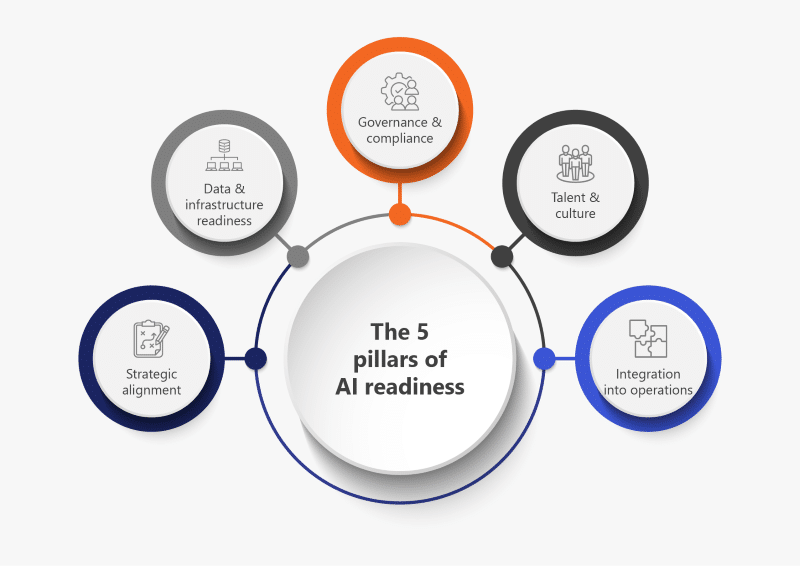6-minute read
Sixty percent of organizations have evaluated enterprise-grade AI tools—but only 20 percent of their initiatives have reached the pilot stage, and just 5 percent made it to production. The numbers tell a clear story: Interest in AI is high, but few efforts are making it across the finish line, let alone delivering results.
The problem isn’t a lack of ambition. Most enterprises are actively exploring AI and eager to put it to work. The real challenge lies in the foundation—those essential elements that make AI viable, scalable, and sustainable in real-world operations.
Readiness isn’t a yes-or-no question. Organizations vary along a spectrum of maturity in five key areas: strategy, data and infrastructure, governance, talent, and operational integration. Strength in one area can accelerate adoption; gaps in another can slow progress.
In this article, we explore these five focus areas that consistently make the difference between experimentation and meaningful impact. Each one offers a lens into what’s working, what’s missing, and where to build next.
Focus area 1: AI strategic alignment
When AI takes root in isolated corners of the business, the results can be innovative—but also scattered, redundant, and difficult to scale. That’s why strategy alignment is the first and most fundamental dimension of readiness.
A strong AI strategy starts with leadership. Direction from the top ensures that investments align with enterprise priorities, resources are allocated wisely, and success is measured against shared goals. Without this alignment, even promising proofs of concept can end up on the shelf because they don’t connect to broader business objectives.
At the same time, alignment from the top doesn’t mean locking down experimentation. Teams still need room to test and explore, but within a framework that guides their efforts toward outcomes that advance enterprise priorities. In this context, the strategy itself functions as the guardrail: leadership defines the destination, while teams innovate on the best ways to get there.
Warning signs of low maturity in AI strategy alignment include:
- Pilots sprouting up in silos with little coordination
- Projects pursued without visible executive support
- Unclear ownership of AI initiatives
- Multiple teams solving the same problem in parallel without realizing it
When organizations achieve maturity in this area, AI becomes more than a collection of experiments. It becomes a deliberate, enterprise-wide capability that grows stronger with every initiative.
Article continues below.
ASSESSMENT
Evaluate your AI readiness across five key areas: strategy alignment, data foundations, governance, talent, and operational integration.
The 5×5 AI Readiness Assessment reveals where your organization stands today and delivers a personalized report with recommended next steps.
Focus area 2: Data and infrastructure readiness
AI depends on data. Clean, well-structured, and traceable information is essential for reliable outcomes. Organizations that struggle with data quality, ownership, or governance quickly discover that AI can amplify problems rather than solve them. Adding a sophisticated tool to a broken foundation won’t make it work better; it just makes the cracks more visible. A model trained on poor inputs will consistently deliver poor results.
Gartner estimates that 60 percent of AI initiatives stall because of messy inputs, underscoring just how critical this foundation is.
Equally important is the infrastructure that supports AI. Even if data is in good shape, outdated or fragile systems can limit scalability, increase costs, and block integration. Readiness in this area demands understanding current capabilities, identifying gaps, and making targeted improvements before bringing AI into production.
Warning signs of low maturity in data and infrastructure readiness include:
- Inconsistent or untraceable data sources
- Lack of ownership or stewardship of data assets
- Limited data governance to control access and usage
- Infrastructure that cannot support scaling AI beyond small pilots
When organizations mature in this area, they gain the ability to move faster and with greater confidence. Reliable data and a scalable infrastructure form the bedrock on which AI initiatives can grow from isolated use cases into enterprise-wide capabilities.
Article continues below.

Focus area 3: Governance and compliance
As AI capabilities grow, so do the risks. Organizations adopting AI must manage challenges ranging from data privacy requirements to ethical considerations. Without clear governance, it becomes difficult to control access, manage risk, or comply with evolving regulations. The stakes are high: Errors or lapses can lead not only to reputational harm, but also to fines and legal exposure.
Governance readiness means more than writing policies. It requires embedding oversight into the AI lifecycle—defining who has access to sensitive data, setting boundaries for how AI systems operate, and creating processes for review before models move into production. Compliance readiness also involves anticipating and mitigating risks such as bias, security vulnerabilities, and “hallucinations” that can produce misleading results.
Warning signs of low maturity in governance and compliance include:
- Sensitive data lacking appropriate access controls
- AI models moving into production without formal review
- Outputs being released without testing for bias or accuracy
- Poorly defined or inconsistently applied oversight roles
- Little to no monitoring of AI systems once deployed in production
Organizations that build maturity in this area establish trust with stakeholders, reduce exposure to regulatory and reputational risk, and ensure AI adoption is sustainable over the long term.

Moving from AI principles to AI policies: Operationalizing AI governance
How organizations can transform AI principles into actionable policies that drive innovation, ensure safety, and build trust through effective AI governance.
Focus area 4: Talent and culture
The most advanced AI strategy can fall flat if the people being asked to use it aren’t ready. Change management is often the deciding factor between enthusiasm and rejection and therefore cannot be treated as an afterthought.
Employees bring their own perspectives, concerns, and levels of comfort with new technology. Some worry about job security, others resist changing established routines, and many simply don’t feel equipped to engage with AI tools. Without support, these barriers can slow or even stop adoption.
A recent survey by Randstad revealed that in companies currently adopting AI, only 35 percent of employees have received AI training—evidence of a talent gap that directly impacts adoption.
Readiness in this area involves more than training sessions. It requires a culture that encourages curiosity, addresses fears directly, and empowers individuals to use AI confidently. Internal champions embedded in teams can help bridge the gap by answering questions, modeling adoption, and keeping communication channels open.
Warning signs of low maturity in talent and culture include:
- Low usage of approved AI tools despite availability
- Few or no internal advocates for adoption
- Resistance to change that surfaces quietly rather than openly
- Minimal opportunities for employees to learn and upskill
When organizations build maturity in this area, AI becomes part of the culture rather than an imposed tool. With training, transparency, and trusted advocates, employees shift from hesitant users to active participants in shaping how AI enhances their work.

Building a culture of AI experimentation
Why enterprises must go beyond tools and pilots to build a culture where experimentation is structured, supported, and expected
Focus area 5: AI integration into operations
AI generates value only when it moves beyond pilots and into day-to-day business processes. Without integration into operations, even the most advanced models remain experiments rather than engines of impact.
There is more to integration readiness than deploying a tool. It requires understanding how AI initiatives connect to business goals, how they scale, and how consistently they deliver results across the enterprise. Assessing maturity requires looking at adoption rates, the reliability of outcomes, and whether business leaders view AI as a trusted contributor to decision-making and performance.
Warning signs of low maturity in AI integration include:
- AI being limited to isolated pilots or proofs of concept
- No inventory of AI initiatives or their business impact
- Few or no use cases operating at scale in production
- Lack of visibility into how AI supports core operations
When organizations advance in this area, AI becomes embedded in business as usual. Productivity tools connect to automation, automation paves the way for transformation, and the enterprise begins to see AI as a strategic capability rather than an experimental add-on.

Breaking the Post-Pilot Barrier: The CIO’s Guide to Scaling AI
5 decision points where IT leaders can shape how AI matures from localized pilots into enterprise-wide capability
AI readiness is just the beginning
AI maturity is best understood as a capability to cultivate over time. As new tools emerge and regulations evolve, the organizations that thrive will be those able to adapt with resilience and consistency, not just those chasing the latest technology.
When leaders treat AI as a core business capability—integrated into strategy, governance, and operations—they apply the same discipline that drives success in finance, risk, and talent management. AI readiness isn’t a one-time checkpoint; it’s an ongoing discipline of tracking performance, closing capability gaps, and adapting to new data, use cases, and risks. Enterprises that take this approach are positioned to capture long-term value from today’s AI while staying prepared for what comes next.
You might also be interested in …

From spreadsheets to strategy: How Workday builds the foundation for AI
Workday, when treated as a platform strategy, gives leaders the clarity to rein in OpEx, expose true talent costs, and build the foundation for agentic AI.

The next era of automation: Why n8n illustrates the future of intelligent platforms
How n8n exemplifies the new standards for enterprise automation while delivering measurable outcomes across core business functions.

What is agentic AI? Benefits, challenges, and how to implement it
Agentic AI blends autonomous reasoning and action to drive strategic business outcomes while introducing new opportunities and challenges.

Accelerate innovation with AI-powered solutions
Logic20/20 helps you turn artificial intelligence into a competitive advantage through strategic planning and responsible implementation. Our experts deliver actionable insights and real-world value through:
- AI strategy & use case development
- Machine learning model design
- Responsible AI frameworks
- AI program implementation & scaling


